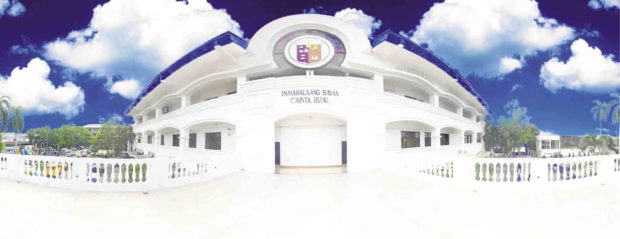
Said to be the oldest settlement in Rizal, Cainta is now a first class municipality and is considered one of the richest in the province, given the influx of property developers and other businesses and investors.
Beginnings
Cainta became a town of Rizal when the province was created in 1901. After being merged in 1903 with the towns of Angono and Taytay, Cainta was converted into a separate, independent municipality in 1914.
It is politically subdivided into seven barangays: Sta Rosa, Sto. Domingo, Sto. Nino, San Andres, San Roque, San Juan and San Isidro. The towns are named alter Catholic saints, a reminder of the town’s highly religious culture and heritage.
Cainta is known to many for its traditional and modernized versions of rituals especially during the Lenten season. These include the Cenaculo (a stage play of the passion and death of Christ) and the Pagpapako or Penetencia (a re-enactment of the crucifixion of Christ).
Potential economic boom
The last several years however had seen the start of what could be an economic boom.
In 2017, Cainta generated a total revenue of P1.2 billion from local taxes, permits and licenses, service, business and other income up from the previous year’s P1.1 billion. For the same year, it received P1.2 billion in appropriations under the General Fund and P148 million under the Special Education Fund. Total assets reached P4 billion in 2017, up by 13.6 percent from P3.5 billion in 2016.
For the two consecutive years of 2016 and 2017, Cainta likewise ranked first overall, as the Most Competitive among first and second class municipalities in the country, under the Cities and Municipalities Competitiveness Index (CMCI).
The National Competitiveness Council earlier explained that the said index gave the private sector a basis for studying cities and determining where to locate their investments in the country. For the CMCI, the NCC measures the competitiveness of a municipality or city based on three pillars namely economic dynamism, government efficiency, and infrastructure. Each pillar has several indicators which provide a more detailed view of the economic status of the locality. It is in terms of these pillars that Cainta has remained highly competitive.
In terms of economic dynamism, Cainta ranked first in the 2018 index. It also ranked third in Infrastructure and 11th in government efficiency. Cainta has to build its competitive strength in terms of resiliency.
Strategic advantage
Location, perhaps, gives Cainta a highly strategic advantage. With the many major thoroughfares linking the municipality to the rest of Metro Manila, Cainta currently serves as one of gateways to the rest of Rizal province. The Cainta Junction, a major busy intersection, adjoins the Metropolitan Highways—Imelda Avenue at the North, A Bonifacio Avenue to the South, and Ortigas Avenue on its East and West Bounds—and connects Metro Manila and Rizal province.
Since it is also situated at the doorstep of the fast growing Calabarzon Region, it stands as the perfect haven for investments and a top location for housing developments.
Housing boom
Its population according to the 2015 Census stood at 322,128, making it one of the highly populated municipalities in the country. Its population rate is high because it has served as an important overspill area of the population from Metro Manila.
As it is near various employment hubs in Metro Manila, Cainta has thus become a strategic residential place for average income families working in the metropolitan area.
The Housing Land Use Regulatory Board lists licenses to sell issued for the building of open market homes, residential condominiums, residential and commercial condominiums and economic housing since 2000.
Among these are the Charm Residences by SM Development Corp., Greenwoods Executive Village and Cainta Green Land by Sta. Lucia Land Inc. Cainta will also soon have the 24-ha Empire East Highland City township, which will consist of 38 residential towers, a 58,000-sqm lifestyle mall, a church with a 500 seating capacity, and an 8,000-sqm green park.
Commercial, retail, industrial
According to its web page, Cainta is considered as one of the commercial and industrial centers in the Rizal province. There were about 6,525 establishments in Cainta in 2016, which include Teletech Customer Care anagement Phils., Inc., Monde M.Y. San Corp. and Ginebra San Miguel Inc.
The municipality’s One Cainta website stated: “If the lifeblood of Cainta’s entire economy is commerce, then the backbone of the municipality’s commercial sector is retail trade.”
Retail activities in the municipality included cars, furniture, heavy machinery and equipment, glass and aluminium, computers and computer parts, tools, appliances, medicines, photo supplies, auto parts, household products, school and office supplies and basic goods, among others.
To facilitate ease of doing business and to build the municipality’s resiliency from natural disasters, infrastructure building is top priority in Cainta.
Among the infrastructure projects here are the LRT Line 2 project which will connect East Metro Manila to the Metro Manila subway. This P9.5 billion-project is expected to be completed by the end of 2020.
The Pasig-Marikina River Channel Improvement Project (Phase 4) will meanwhile provide Cainta with a new floodgate. This is a joint partnership with DPWH and Japan International Cooperation Agency.
Another ongoing project is the construction of the East-west Bank Bridge 2 in Cainta, Rizal. ADB will fund the project which has a target date of implementation in 2020 and is expected to end in 2023. The project is part of the Pasig-Marikina and River Manggahan Floodway Bridges Construction. With research from Zathea Kate L. Dela Pena, Martha Pangilinan, Andrea Rose D. Gregorio, Inquirer Junior Interns
Sources: Inquirer Archives; COA, HLURB webpages, cainta.gov.ph, dti.gov.ph, build.gov.ph, jica.go.jp


